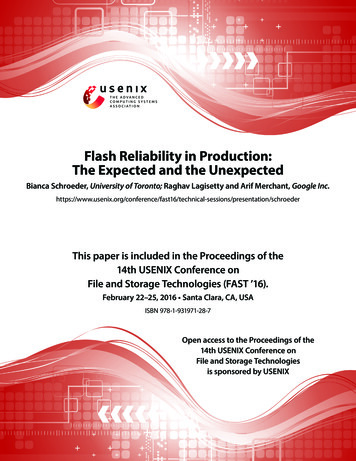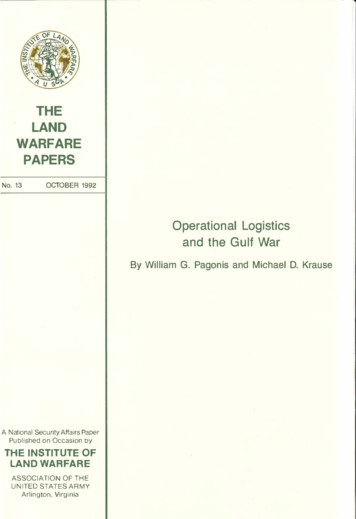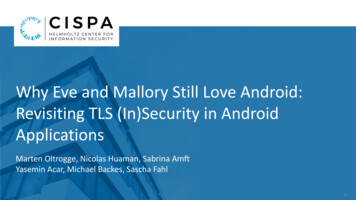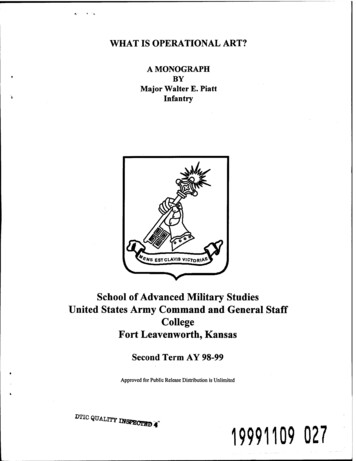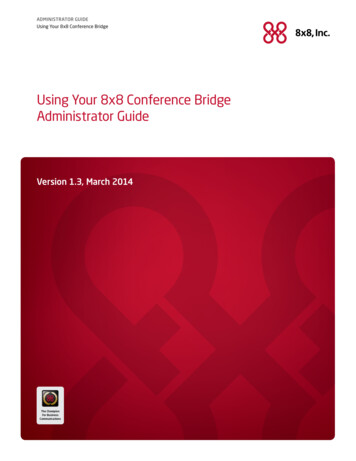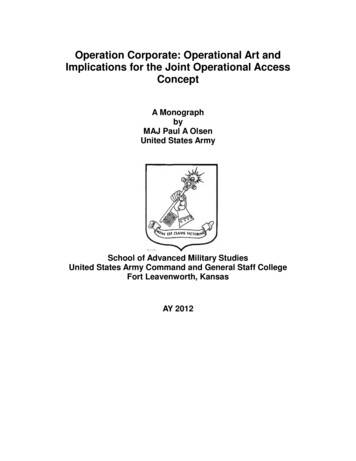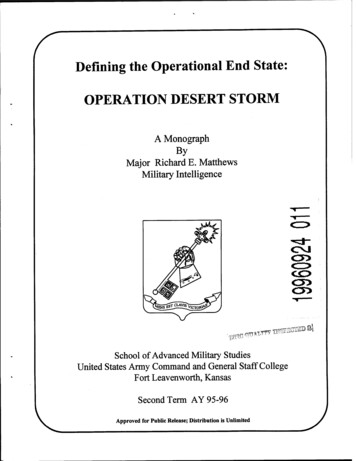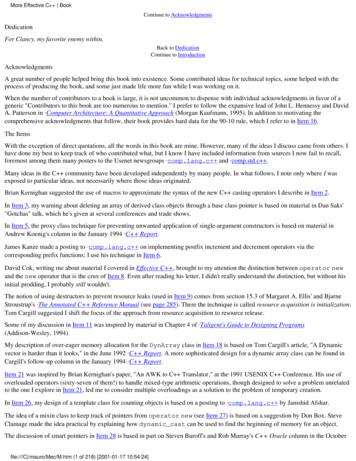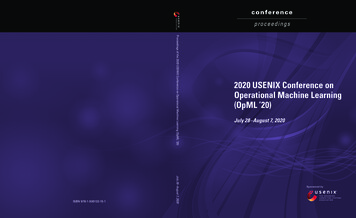
Transcription
c onfer e nc ep roceedi ngsProceedings of the 2020 USENIX Conference on Operational Machine Learning (OpML ’20)July 28–August 7, 2020ISBN 978-1-939133-15-12020 USENIX Conference onOperational Machine Learning(OpML ’20)July 28–August 7, 2020Sponsored by
OpML ’20 SponsorsBronze SponsorOpen Access SponsorUSENIX SupportersUSENIX PatronsBloomberg Facebook GoogleMicrosoft NetAppUSENIX BenefactorsAmazon Oracle Thinkst CanaryTwo Sigma VMwareUSENIX PartnersTop10VPNOpen Access Publishing PartnerPeerJ
USENIX AssociationProceedings of the2020 USENIX Conference onOperational Machine Learning (OpML ’20)July 28–August 7, 2020
2020 by The USENIX AssociationAll Rights ReservedThis volume is published as a collective work. Rights to individual papers remain with the author or the author’s employer. Permission is granted for the noncommercial reproduction of the complete work for educational or researchpurposes. P ermission is granted to print, primarily for one person’s exclusive use, a single copy of these Proceedings.USENIX acknowledges all trademarks herein.ISBN 978-1-939133-15-1Cover Image created by freevector.com and distributed under the Creative Commons Attribution-ShareAlike 4.0license (https://creativecommons.org/licenses/by-sa/4.0/).
Conference OrganizersProgram Co-ChairsNisha Talagala, Pyxeda AIJoel Young, LinkedInProgram CommitteeFei Chen, LinkedInSindhu Ghanta, ParallelMKun Liu, AmazonPrassana Padmanaban, NetflixNeoklis Polyzotis, GoogleSuresh Raman, IntuitBharath Ramsundar, Stealth ModeMarius Seritan, Argo AIFaisal Siddiqi, NetflixSwaminathan Sundararaman, PyxedaEno Thereska, AmazonBoris Tvaroska, LenovoTodd Underwood, GoogleSandeep Uttamchandani, IntuitManasi Vartak, Verta AIJesse Ward, LinkedInSteering CommitteeNitin Agrawal, SamsungEli Collins, Accel Partners/Samba NovaCasey Henderson, USENIX AssociationRobert Ober, NvidiaBharath Ramsundar, Stealth ModeJairam Ranganathan, UberD. Sculley, GoogleTal Shaked, GoogleSwaminathan SundararamanNisha Talagala, Pyxeda AISandeep Uttamchandani, IntuitJoel Young, LinkedIn
Message from theOpML ’20 Program Co-ChairsWelcome to OpML 2020!We are very excited to launch the second annual USENIX Conference on Operational Machine Learning (OpML).Machine Learning is interlaced throughout our society bringing new challenges in deploying, managing, and optimizingthese systems in production while maintaining fairness and privacy. We started OpML to provide a forum where practitioners, researchers, industry, and academia can gather to present, evaluate, and debate the problems, best practices, and latestcutting-edge technologies in this critical emerging field. Managing the ML production lifecycle is a necessity for wide-scaleadoption and deployment of machine learning and deep learning across industries and for businesses to benefit from the coreML algorithms and research advances.The conference received strong interest this year, with 54 submissions spanning both academia and industry. Thanks to thehard work of our Program Committee, we created an exciting program with 26 technical presentations with eight Ask-MeAnything sessions with the authors. Each presentation and paper submission was evaluated by 3–5 PC members, with thefinal decisions made during a half-day online PC meeting.This has been an exceptionally challenging time for our authors and speakers, for our program committee, and for the world.Given safety concerns and travel restrictions, this year we are experimenting with a new format with eight Ask-Me-Anythingsessions hosted on Slack. Each presenter has prepared both short and long form videos and will be online to answer questionsduring their session. Furthermore, the conference is free to attend for all participants!We would like to thank the many people whose hard work made this conference possible. First and foremost, we would liketo thank the authors for their incredible work and the submissions to OpML ’20. Thanks to the Program Committee for theirhard work in reviews and spirited discussion (Bharath Ramsundar, Boris Tvaroska, Eno Thereska, Faisal Siddiqi, Fei Chen,Jesse Ward, Kun Liu, Manasi Vartak, Marius Seritan, Neoklis Polyzotis, Prasanna Padmanabhan, Sandeep Uttamchandani,Sindhu Ghanta, Suresh Raman, Swami Sundaraman, and Todd Underwood).We would also like to thank the members of the steering committee for their guidance throughout the process (BharathRamsundar, Sandeep Uttamchandani, Swaminathan (Swami) Sundaraman, Casey Henderson, D. Sculley, Eli Collins, JairamRanganathan, Nitin Agrawal, Robert Ober, and Tal Shaked).Finally, we would like to thank Casey Henderson and Kurt Andersen of USENIX for their tremendous help and insight as weworked on this new conference, and all of the USENIX staff for their extraordinary level of support throughout the process.We hope you enjoy the conference and proceedings!Best Regards,Nisha Talagala, Pyxeda AIJoel Young, LinkedIn
2020 USENIX Conference onOperational Machine Learning (OpML ’20)July 28–August 7, 2020Tuesday, July 28Session 1: Deep LearningDLSpec: A Deep Learning Task Exchange Specification. . . . . . . . . . . . . . . . . . . . . . . . . . . . . . . . . . . . . . . . . . . . . . . . . . . . 1Abdul Dakkak and Cheng Li, University of Illinois at Urbana-Champaign; Jinjun Xiong, IBM T. J. Watson Research Center;Wen-mei Hwu, University of Illinois at Urbana-ChampaignWednesday, July 29Session 2: Model Life CycleFinding Bottleneck in Machine Learning Model Life Cycle . . . . . . . . . . . . . . . . . . . . . . . . . . . . . . . . . . . . . . . . . . . . . . . . . 5Chandra Mohan Meena, Sarwesh Suman, and Vijay Agneeswaran, WalmartLabsThursday, July 30Session 3: Features, Explainability, and AnalyticsDetecting Feature Eligibility Illusions in Enterprise AI Autopilots . . . . . . . . . . . . . . . . . . . . . . . . . . . . . . . . . . . . . . . . . . . 9Fabio Casati, Veeru Metha, Gopal Sarda, Sagar Davasam, and Kannan Govindarajan, ServiceNow, Inc.Time Travel and Provenance for Machine Learning Pipelines. . . . . . . . . . . . . . . . . . . . . . . . . . . . . . . . . . . . . . . . . . . . . . 13Alexandru A. Ormenisan, KTH - Royal Institute of Technology and Logical Clocks AB; Moritz Meister, Fabio Buso,and Robin Andersson, Logical Clocks AB; Seif Haridi, KTH - Royal Institute of Technology; Jim Dowling, KTH - RoyalInstitute of Technology and Logical Clocks ABAn Experimentation and Analytics Framework for Large-Scale AI Operations Platforms . . . . . . . . . . . . . . . . . . . . . . 17Thomas Rausch, TU Wien and IBM Research AI; Waldemar Hummer and Vinod Muthusamy, IBM Research AIChallenges Towards Production-Ready Explainable Machine Learning. . . . . . . . . . . . . . . . . . . . . . . . . . . . . . . . . . . . . . 21Lisa Veiber, Kevin Allix, Yusuf Arslan, Tegawendé F. Bissyandé, and Jacques Klein, SnT – Univ. of LuxembourgFriday, July 31Session 4: AlgorithmsRIANN: Real-time Incremental Learning with Approximate Nearest Neighbor on Mobile Devices. . . . . . . . . . . . . . . 25Jiawen Liu and Zhen Xie, University of California, Merced; Dimitrios Nikolopoulos, Virginia Tech; Dong Li,University of California, MercedTuesday, August 4Session 5: Model Deployment StrategiesFlexServe: Deployment of PyTorch Models as Flexible REST Endpoints . . . . . . . . . . . . . . . . . . . . . . . . . . . . . . . . . . . . . 29Edward Verenich, Clarkson University and Air Force Research Laboratory; Alvaro Velasquez, Air Force ResearchLaboratory; M. G. Sarwar Murshed and Faraz Hussain, Clarkson UniversityWednesday, August 5Session 6: Applications and ExperiencesAuto Content Moderation in C2C e-Commerce . . . . . . . . . . . . . . . . . . . . . . . . . . . . . . . . . . . . . . . . . . . . . . . . . . . . . . . . . . 33Shunya Ueta, Suganprabu Nagaraja, and Mizuki Sango, Mercari Inc.Challenges and Experiences with MLOps for Performance Diagnostics in Hybrid-Cloud Enterprise SoftwareDeployments . . . . . . . . . . . . . . . . . . . . . . . . . . . . . . . . . . . . . . . . . . . . . . . . . . . . . . . . . . . . . . . . . . . . . . . . . . . . . . . . . . . . . . . 37Amitabha Banerjee, Chien-Chia Chen, Chien-Chun Hung, Xiaobo Huang, Yifan Wang, and Razvan Chevesaran, VMware Inc.
DLSpec: A Deep Learning Task Exchange SpecificationAbdul Dakkak1* , Cheng Li1* , Jinjun Xiong2 , Wen-mei Hwu11 University of Illinois Urbana-Champaign, 2 IBM T. J. Watson Research Center{dakkak, cli99, w-hwu}@illinois.edu, jinjun@us.ibm.comAbstractDeep Learning (DL) innovations are being introduced ata rapid pace. However, the current lack of standard specification of DL tasks makes sharing, running, reproducing, andcomparing these innovations difficult. To address this problem, we propose DLSpec, a model-, dataset-, software-, andhardware-agnostic DL specification that captures the differentaspects of DL tasks. DLSpec has been tested by specifyingand running hundreds of DL tasks.1IntroductionThe past few years have seen a fast growth of Deep Learning(DL) innovations such as datasets, models, frameworks, software, and hardware. The current practice of publishing theseDL innovations involves developing ad-hoc scripts and writing textual documentation to describe the execution processof DL tasks (e.g., model training or inference). This requiresa lot of effort and makes sharing and running DL tasks difficult. Moreover, it is often hard to reproduce the reportedaccuracy or performance results and have a consistent comparison across DL tasks. This is a known [7, 8] “pain point”within the DL community. Having an exchange specificationto describe DL tasks would be a first step to remedy this andease the adoption of DL innovations.Previous work included curation of DL tasks in frameworkmodel zoos [3, 6, 12–14, 18], developing model catalogs thatcan be used through a cloud provider’s API [1, 2, 5], or introducing MLOps specifications [4, 19, 20]. However, thesework either use ad-hoc techniques for different DL tasks orare tied to a specific hardware or software stack.We propose DLSpec, a DL artifact exchange specificationwith clearly defined model, data, software, and hardware aspects. DLSpec’s design is based on a few key principles (Section 2). DLSpec is model-, dataset-, software-, and hardwareagnostic and aims to work with runtimes built using existingMLOp tools. We further develop a DLSpec runtime to support DLSpec’s use for DL inference tasks in the context ofbenchmarking [9]. Thetwo authors contributed equally to this paper.USENIX Association2Design PrinciplesWhile the bottom line of a specification design is to ensurethe usability and reproducibility of DL tasks, the followingprinciples are considered to increase DLSpec’s applicability:Minimal — To increase the transparency and ease the creation, the specification should contain only the essential information to use a task and reproduce its reported outcome.Program-/human-readable — To make it possible to develop a runtime that executes DLSpec, the specificationshould be readable by a program. To allow a user to understand what the task does and repurpose it (e.g., use a differentHW/SW stack), the specification should be easy to introspect.Maximum expressiveness — While DL training and inference tasks can share many common software and hardware setups, there are differences when specifying their resources, parameters, inputs/outputs, metrics, etc. The specification mustbe general to be used for both training and inference tasks.Decoupling DL task description — A DL task is describedfrom the aspects of model, data, software, and hardwarethrough their respective manifest files. Such decoupling increases the reuse of manifests and enables the portability ofDL tasks across datasets, software, and hardware stacks. Thisfurther enables one to easily compare different DL offeringsby varying one of the four aspects.Splitting the DL task pipeline stages — We demarcatethe stages of a DL task into pre-processing, run, and postprocessing stages. This enables consistent comparison andsimplifies accuracy and performance debugging. For example,to debug accuracy, one can modify the pre- or post-processingstep and observe the accuracy; and to debug performance, onecan surround the run stage with the measurement code. Thisdemarcation is consistent with existing best practices [11, 17].Avoiding serializing intermediate data into files — A naiveway to transfer data between stages of a DL task is to usefiles. In this way, each stage reads a file containing input dataand writes to a file with its output data. This approach can beimpractical since it introduces high serializing/deserializingoverhead. Moreover, this technique would not be able to support DL tasks that use streaming data.2020 USENIX Conference on Operational Machine Learning1
1Hardwareid: uuidcpu:- arch: x86-64- ncpu: 4- gpu:- arch: nvidia/sm70- memory: 16gb- driver version: XXX- interconnect: nvlink2memory: 32gb 2setup: echo 1 /sys/devices/system/cpu/intel pstate/no turbo3Softwareid: uuidname: Tensorflow # framework nameversion: 1.0.0 # semantic versioncontainer: dlspec/tf:2-1-0 amd64-gpuenv:- TF ENABLE WINOGRAD NONFUSED: 04Datasetid: uuidname: ILSVRC 2012version: 1.0.0 # semantic versionlicense: # dataset licensesources:- source: s3:// /test set.zipname: test set- source: 5id: uuid # model unique idname: Inception-v3 # model nameversion: 1.0.0 # semantic versionlicense: MIT # model licenseauthor: Jane Doe # model authortask: image classificationdescription: 6pre-process: Modeldef pre processing(ctx, data):from PIL import Imageimg Image.open(data[“test set”][0])img np.asarray(img)img np.transpose(img, (2,0,1)) return pre processed datainputs: # model inputs7 - type: image # 1st input modalitylayer name: dataelement type: float328job type: inference # or trainingrun: 9def run(ctx, data): # tf.Session.run(ctx[“model”], data)return run outputmodel: # model for retraining or inferencegraph path: https://./inception v3.pbchecksum: XXXX XXXX11post-process: 10def post processing(ctx, data): # e.g. import numpy as npreturn post processed dataoutputs: # model outputs12 - type: probability # 1st output modalitylayer name: probelement type: float32system requirements: [gpu]DLSpec RuntimeFigure 1: An example DLSpec that consists of a hardware, software, dataset and model manifest.3DLSpec DesignA DLSpec consists of four manifest files and a reference logfile. All manifests are versioned [15] and have an ID (i.e., canbe referenced). The four manifests (shown in Figure 1) are: Hardware: defines the hardware requirements for a DLtask. The parameters form a series of hardware constraintsthat must be satisfied to run and reproduce a task. Software: defines the software environment for a DL task.All executions occur within the specified container. Dataset: defines the training, validation, or test dataset. Model: defines the logic (or code) to run a DL task and therequired artifact sources.The reference log is provided by the specification authorfor others to refer to. The reference log contains the IDs of themanifests used to create it, achieved accuracy/performance onDL task, expected outputs, and author-specified information(e.g. hyper-parameters used in training).We highlight the key details of DLSpec:Containers — A software manifest specifies the containerto use for a DL task, as well as any configuration parametersthat must be set (e.g., framework environment variables). Theframework or other libraries information are listed for ease ofinspection and management.Hardware configuration — While containers provide a standard way of specifying the software stack, a user cannot specify some hardware settings within a container. E.g., it is notpossible to turn off Intel’s turbo-boosting (Figure 1 2 ) withina container. Thus, DLSpec specifies hardware configurationsin the hardware manifest to allow the runtime to set themoutside the container environment.Pre-processing, run, and post-processing stages — Thepre-/post-processing and run stages are defined via Pythonfunctions embedded within the manifest. We do this becausea DLSpec runtime can use the Python sub-interpreter [16]to execute the Python code within the process, thus avoiding using intermediate files (see Section 2). Using Pythonfunctions also allows for great flexibility; e.g., the Pythonfunction can download and run Bash and R scripts or download, compile, and some C code. The signature of the DLSpec Python functions is fun(ctx, data) where ctx is ahash table that includes manifest information (such as thetypes of inputs) accepted by the model. The second argument,22020 USENIX Conference on Operational Machine Learningdata, is the output of the previous step in the dataset preprocessing run post-processing pipeline. In Figure 1, forexample, the pre-processing stage’s 6 data is the list of filepaths of the input dataset (ImageNet test set in this case).Artifact resources — DL artifacts used in a DL task arespecified as remote resources within DLSpec. The remoteresource can be hosted on an FTP, HTTP, or file server (e.g.,AWS S3 or Zenodo) and have a checksum which is used toverify the download.4DLSpec RuntimeWhile a DL practitioner can run a DL task by manually following the setup described in the manifests, here we describehow a runtime (i.e., an MLOps tool) can use the DLSpecmanifests shown in Figure 1.A DLSpec runtime consumes the four manifests and selectsthe 1 hardware to use, and runs any 2 setup code specified(outside the container). A 3 container is launched using theimage specified, and the 4 dataset is downloaded into thecontainer using the 5 URLs provided. The 6 dataset filepaths are passed to the pre-processing function and its outputsare then processed to match the 7 model’s input parameters.The 9 DL task is run. In the case of 8 inference, this causesthe 10 model to be downloaded into the container. The resultsfrom the run are then 11 post-processed using the 12 dataspecified by the model outputs.We tested DLSpec in the context of inference benchmarking and implemented a runtime for it [9, 10]. We collectedover 300 popular models and created reusable manifests foreach. We created software manifests for each major framework (Caffe, Caffe2, CNTK, MXNet, PyTorch, TensorFlow,TensorFlow Lite, and TensorRT), dataset manifest (ImageNet,COCO, Pascal, CIFAR, etc.), and then wrote hardware specsfor X86, ARM, and PowerPC. We tested our design andshowed that it enables consistent and reproducible evaluation of DL tasks at scale.5ConclusionAn exchange specification, such as DLSpec, enables a streamlined way to share, reproduce, and compare DL tasks. DLSpectakes the first step in defining a DL task for both training andinference and captures the different aspects of DL modelreproducibility. We are actively working on refining the specifications as new DL tasks are introduced.USENIX Association
References[1] Amazon SageMaker. https://aws.amazon.com/sagemaker, 2020. Accessed: 2020-02-20.[2] MLOps: Model management, deployment and monitoring with Azure Machine Learning. . Accessed: 2020-02-20.[3] Caffe2 model zoo. https://caffe2.ai/docs/zoo.html, 2020. Accessed: 2020-02-20.[4] Grigori Fursin, Herve Guillou, and Nicolas Essayan.CodeReef: an open platform for portable MLOps,reusable automation actions and reproducible benchmarking. arXiv preprint arXiv:2001.07935, 2020.[5] Architecture for MLOps using TFX, Kubeflow Pipelines,and Cloud Build. https://bit.ly/39P6JFk, 2020.Accessed: 2020-02-20.[6] GluonCV. https://gluon-cv.mxnet.io/, 2020. Accessed: 2020-02-20.[7] Odd Erik Gundersen and Sigbjørn Kjensmo. State ofthe art: Reproducibility in artificial intelligence. InThirty-Second AAAI Conference on Artificial Intelligence, 2018.[8] Matthew Hutson. Artificial intelligence faces reproducibility crisis, 2018.[9] Cheng Li, Abdul Dakkak, Jinjun Xiong, and Wen-meiHwu. The Design and Implementation of a Scalable DL Benchmarking Platform. arXiv preprintarXiv:1911.08031, 2019.[10] Cheng Li, Abdul Dakkak, Jinjun Xiong, Wei Wei,Lingjie Xu, and Wen-Mei Hwu. XSP: Across-StackProfiling and Analysis of Machine Learning Modelson GPUs. IEEE, May 2020. The 34th IEEE International Parallel & Distributed Processing Symposium(IPDPS’20).USENIX Association[11] Peter Mattson, Christine Cheng, Cody Coleman, GregDiamos, Paulius Micikevicius, David Patterson, Hanlin Tang, Gu-Yeon Wei, Peter Bailis, Victor Bittorf,et al. Mlperf training benchmark. arXiv preprintarXiv:1910.01500, 2019.[12] Modelhub. http://modelhub.ai, 2020. Accessed:2020-02-20.[13] ModelZoo. https://modelzoo.co, 2020. Accessed:2020-02-20.[14] ONNX Model Zoo. https://github.com/onnx/models, 2020. Accessed: 2020-02-20.[15] Tom Preston-Werner. Semantic versioning 2.0.0. https://www.semver.org, 2019.https:[16] Initialization, Finalization, and ssed:sub-interpreter-support, 2019.2020-02-20.[17] Vijay Janapa Reddi, Christine Cheng, David Kanter, Peter Mattson, Guenther Schmuelling, Carole-Jean Wu,Brian Anderson, Maximilien Breughe, Mark Charlebois,William Chou, et al. Mlperf inference benchmark. arXivpreprint arXiv:1911.02549, 2019.[18] TensorFlow Hub. https://www.tensorflow.org/hub, 2020. Accessed: 2020-02-20.[19] Manasi Vartak, Harihar Subramanyam, Wei-En Lee,Srinidhi Viswanathan, Saadiyah Husnoo, Samuel Madden, and Matei Zaharia. ModelDB: a system for machine learning model management. In Proceedings ofthe Workshop on Human-In-the-Loop Data Analytics,pages 1–3, 2016.[20] Matei Zaharia, Andrew Chen, Aaron Davidson, AliGhodsi, Sue Ann Hong, Andy Konwinski, SiddharthMurching, Tomas Nykodym, Paul Ogilvie, Mani Parkhe,et al. Accelerating the machine learning lifecycle withmlflow. Data Engineering, page 39, 2018.2020 USENIX Conference on Operational Machine Learning3
Finding Bottleneck in Machine Learning Model Life CycleChandra Mohan MeenaWalmartLabsSarwesh SumanWalmartLabsVijay AgneeswaranWalmartLabsAbstractOur data scientists are adept in using machine learning algorithms and building model out of it, and they are at ease withtheir local machine to do them. But, when it comes to buildingthe same model from the platform, they find it slightly challenging and need assistance from the platform team. Based onthe survey results, the major challenge was platform complexity, but it is hard to deduce actionable items or accurate detailsto make the system simple. The complexity feedback wasvery generic, so we decided to break it down into two logicalchallenges: Education & Training and Simplicity-of-Platform.We have developed a system to find these two challenges inour platform, which we call an Analyzer. In this paper, weexplain how it was built and it’s impact on the evolution ofour machine learning platform. Our work aims to addressthese challenges and provide guidelines on how to empowermachine learning platform team to know the data scientist’sbottleneck in building model.1Figure 1: System ArchitectureIntroductionWe have a good strength of data scientists in Walmart. Oursystem has counted more than 393 frequent users and 998infrequent users. The data scientists are from various teamsin Walmart. We have seen various kinds of challenges inthe evolution of our platform to support end to end Machinelearning (ML) model life cycle. We have observed that ourdata scientists are not able to use the platform effectively. Lessadoption of our platform is the key challenge for us to solve.It is not sufficient to be completely dependent on surveysto improve our system as people often lie in user surveys,possibly due to a phenomenon known as social desirabilitybias [2].Analyzer approach: We have instrumented our machinelearning platform (MLP) to collect data for analysing howusers interact with the platform. We named the data collectedor sent from a product or a feature as signals. Example ofsignals are clicks, interaction with MLP features, time spentUSENIX Associationon features, time to complete certain actions, and so on. Wehave created various classes of signals for our product: MLPaction signals (e.g., key-actions, clicks, and views), MLPerror signals (e.g., error in each component) and MLP-timesignal (e.g., time on component, component load time, minutes per session) [3, 4]. We have defined four stages of theML lifecycle, namely, “Data collection,cleaning,labeling”,“Feature Engineering”, “Model training” and “Model deployment” [1]. In each stage signals are generated for the Analyzerto capture particular challenges faced by user. We presenttwo dimensions of challenges: Education-&-Training (ET)and Simplicity-of-Platform (SoP). In ET, the focus is on adata scientist’s capability and self-sufficiency to use the MLPand SoP focuses on the technical or design challenges in MLlifecycle. The Fig. 1 shows our system architecture.2020 USENIX Conference on Operational Machine Learning5
than 5 times in a week/month then it is mapped to SoPchallenge4. If less than 10% expert and more than 50% intermediateand 75% does redundent actions more than 5 times in aweek/month then it is mapped to ET challengeChallengeEducation & TrainingSimplicity-of-PlatformFigure 2: Collection of Signals2Signal CollectionOur instrumentation framework collect user actions from platform and sends it to our instrumentation service. We considerall actions as events and store them in our event repository(database). The signal generator reads the data from the repository and classifies it into multiple signals. We name the datacollected or sent form product or feature as signals. Exampleof signals are clicks, interaction with the tools, time spenton the tools, time to complete certain actions. These signalsare mapped to multiple classes: MLP-actions, MLP-error andMLP-time. The signal generator annotates these classes ofsignals with the user and platform related meta-data and storesit into a datastore. Our Analyzer runs the final show. It goesthrough each new signal and evaluates respective stage wisebottleneck for a user. Fig. 2 describes this flow.31. If more than 50% expert and 65% intermediate and 80%beginner users see the error signal then it is mapped toSoP challenge2. If less than 10% expert and more than 65% intermediateand 80% beginner users see the error signal then it ismapped to ET challenge3. if more than 50% expert does redundent actions more6Table 1: Platform challengesAbove table depicts different instances of ET and SoPchallenge at different stages. Some of critical instances aredescribed below:a) Model-training stage has a default cut-off time, beyondwhich jobs are terminated automatically. Analyzer hasmapped these signals as ET challenge, based on rule-1,where we found users were unaware of this feature.b) Data-collection stage provides connectors which enableusers to retrieve data from varied data sources. Analyzerhas mapped these signals as ET challenge, based on rule4. We have discovered that users prefer creating theirown connectors instead of reusing the existing ones, thusresulting in lot of duplicity.c) Feature-engineering stage, user see a list of notebooks.Notebook IDE runs in a kubernetes container, if notebook is idle for longer than 6 hours then notebook becomes inactive. User need to activate notebook in orderto open it. If there is no enough resource available thendisplay error. Analyzer has mapped these signal as SoPchallenge, based on rule-1.AnalyzerIn this section, we summarize the design of Analyzer, a system that uses a user-behaviour-segregation-model and set ofrules to evaluate challenges of using MLP. The model usesK-means clustering technique, which groups the users basedon action and time signals and later by looking at the centroid/clustor representative values. Users in the group arelabelled as: Beginner, Intermediate and Expert. Our modelhas suggested 85 Expert, 118 Intermediate and 190 Beginnerusers of our platform. We have defined set of rules for eachdifferent type of signal. Analyzer applies these rules and smellthe challenge from signal. We have defined following set ofrules:2020 USENIX Conference on Operational Machine LearningCount176Analyzer has been running in production for last 4 monthsand these above instances are the outcome of our data analysis.This has helped our product team to build better Educationand Training (effective tutorial, documentation and videos)for model-training and data-connectors features. Above SoPinstance: ’c’ highlighted the complexity which user faces increating notebook in Feature-engineering stage. This enabledproduct team to integrate live resource information on thenotebook list page as part of UX improvement.4ConclusionThe Analyser has identified 17 and 6 instances respectively ofEducation-&-Training (ET) and Simplicity of Platform (SoP )challenges. ET instances have enabled product team to createeffective set of documentation and tutorials. SoP instanceshelped in the evolution of ML Platform as a whole. OurUSENIX Association
Analyzer helps us directly in making data driven decisions toimprove user adoption. We believe that our Analyzer can beadopted by other Machine Learning Platform teams facingsimilar challenges. In future, we will add more challenges(ex: Scale, Performance, Hardware-Resources) and use DeepLearning for deriving more insights from these signals.AcknowledgmentsWe would like to acknowledge our colleagues who builtML Platform, Senior Director: Ajay Sharma for the opportunity, Distinguised Architect
Jesse Ward, LinkedIn Steering Committee Nitin Agrawal, Samsung . Kevin Allix, Yusuf Arslan, Tegawendé F. Bissyandé, and Jacques Klein, SnT – Univ. of Luxembourg . DL innovations involves developing ad-hoc
